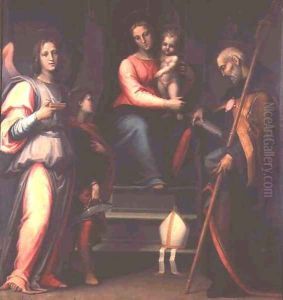Bartolommeo Sogliani Paintings
Bartolommeo Sogliani was an Italian painter of the Renaissance period, born in 1497 in Florence, Italy. His contributions to art are often overshadowed by the monumental figures of his time, such as Leonardo da Vinci and Michelangelo, but Sogliani nonetheless played a significant role in the development of Florentine painting during the early 16th century. His work is characterized by its delicate execution, attention to detail, and the serene and harmonious qualities typical of the High Renaissance style.
Sogliani received his early training in the workshop of Lorenzo di Credi, a pupil of Verrocchio, where he absorbed the principles of Florentine painting, emphasizing line and clear form. This foundation was crucial in shaping Sogliani's style, which later evolved to incorporate influences from other contemporary artists, including Raphael and Fra Bartolomeo. Despite these influences, Sogliani developed a distinct approach, particularly in his religious compositions, where he demonstrated a unique ability to convey piety and devotion through the gentle expressions and poses of his figures.
Throughout his career, Sogliani worked on various commissions for churches and monasteries in Florence and its surroundings, including altarpieces, frescoes, and smaller devotional paintings. One of his most notable works is the altarpiece for the church of San Lorenzo in Florence, which showcases his skill in composition and his ability to render figures with a sense of grace and dignity. Sogliani's work was also appreciated for its narrative quality, as he was adept at incorporating multiple scenes or episodes within a single composition, a technique that added depth and richness to his storytelling.
Despite his contributions to the Florentine art scene, Sogliani did not achieve the same level of fame as some of his contemporaries. His work, however, was recognized for its quality during his lifetime, and he was respected by his peers. After his death in 1544, Sogliani's reputation waned, and he was largely forgotten until art historians began to reevaluate his work in the 19th and 20th centuries, acknowledging his role in the broader context of Renaissance art.
Today, Sogliani is remembered as a talented but somewhat underappreciated artist of the Renaissance, whose works offer insight into the transitional period of Florentine painting from the High Renaissance to the Mannerist style. His legacy is preserved in the collections of various museums and churches, where his paintings continue to be studied and admired for their beauty and historical significance.




